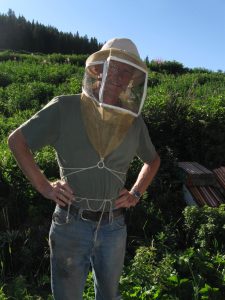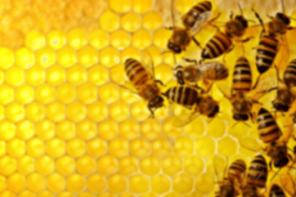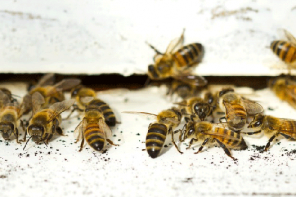By: Ed Colby
Playing Hooky
In January the gal Marilyn and I took the overnight Amtrak from Colorado to Reno for the 2018 American Beekeeping Federation conference. But first, our train hit an abandoned automobile outside of Chicago. Then, coming out of the Moffat Tunnel in Colorado, it had to slam on the brakes for a skier on the tracks at the base of the Winter Park ski area.
We boarded six hours late in Grand Junction. Sometimes Amtrak can catch up when they’re behind, but not this time. They’d replaced the wrecked Amtrak engine with a slower freight locomotive, so we continued to lose time and arrived in Reno seven hours late on Sunday.
Reno advertises itself as the “Biggest Little City in the World.” It’s an interesting little town, I’ll say that. Our well-appointed downtown Airbnb condo was located next to the Truckee River, across the river from the blinding lights of the casinos. In an odd juxtaposition of Reno architectural styles, tawdry 1950 and 1960s motels sprout like weeds among glittering high rise monoliths. The homeless sleep in vacant lots or wherever they can find shelter.
The place drips with sex. Gambling billboards feature women with big-lipstick smiles, leaning seductively on Hollywood-handsome men at blackjack tables. A sign in the window of the Cal-Neva casino features three very naughty ladies beckoning you to play “beer pong” in the Pleasure Pit. The legal brothels are all out of town.
You can also get married in Reno. Wedding chapels flourish everywhere. At the Chapel of the Bells drive-through, you can get hitched in your car.
I wanted to hear Randy Oliver’s talk on his adventures with oxalic acid for Varroa mite control on the opening day of the conference. Instead I fell under the sway of Marilyn and Michigan State bee researcher Meghan Milbrath and went skiing. We picked up Dr. Milbrath at the conference venue, where she was staying. She kept her head down as she dragged her ski bag past other conference attendees, hoping no one would catch her playing hooky. Let it go, Girl! This is Reno, land of forbidden pleasure!
On the drive up to Mt. Rose, Meghan gave me ideas for how to structure a beginners’ bee class, sorely needed where Marilyn and I live out in the boonies. I don’t have time for teaching classes, but somebody has to do it! Then it hit me – I was talking bees with a professional bee researcher. This was a business ski trip! I could write off my lift ticket!
The wind howled at the ski hill. Mt. Rose only had a couple of lifts open. It rained the day before. Icicles dripped from pine boughs. We jumped on the lift and talked bees.
We talked about neonicotinoids, the controversial systemic pesticides now very much in vogue. Meghan explained that the neonics don’t all act exactly the same in the environment and as stressors on pollinators. We talked about risk assessment and how we humans make decisions relating to risk. Meghan brought up pumping your own gas. Gasoline contains benzene, a known carcinogen. Every time you pump gasoline, you assume some cancer risk. Exposure to benzene is an enhanced risk for people in poor health. But as a society, in general we agree that pumping your own gas is worth the risk.
We talked about fungicides and neonics as synergistic bad ju-ju and about recent research indicating that fungicides serve as pollinator attractors. In other words, bees may prefer flowers coated with fungicides.
Our lift ride went pretty fast! We followed Marilyn down the ski hill. Marilyn likes to be the leader, and Meghan and I like to follow. Marilyn can be hard to keep up with!
On the lift again, we discussed how difficult it is to prove something scientifically, and how preconceived notions and points of view color our perceptions of reality. We talked about the funding of research by interested parties, i.e. pesticide research conducted and paid for by pesticide manufacturers. “Who else has the money?” Meghan queried.
We agreed that neonic seed treatments violated a principle of Integrated Pest Management. In IPM, you use the lowest dose of insecticide that’ll do the job, and then only when you absolutely need it. With neonic seed treatments, you treat the problem when you plant, before you even have a problem. Dr. Milbrath explained that for crops normally coated with neonics, like corn, soybeans and Canola, farmers can’t even buy non-treated seed. They’re stuck with treated seed, whether they want it or not. When she needed some non-treated corn seed, she had to drive to Indiana to find it.
At the top of the lift, we hiked uphill a few steps to a place where few skiers ventured. We descended through an enchanted forest of wind-battered pines and twisted tree snags. Lake Tahoe shimmered in the distance. Meghan got too far forward on her free-heel skis and augered in face first. She got up laughing, the little darling! We never stopped for lunch.
Back on the lift, we kept congratulating ourselves for ditching the ABF conference. Finally I said, “This has gotta be more fun than Randy Oliver’s lecture!”
“I’ll tell him you said so,” Meghan said. Her smile stretched across the snow-capped Sierras.
Ed Colby practices beekeeping in Aspen Mountain, Colorado, where he lives with his partner, Marilyn.










